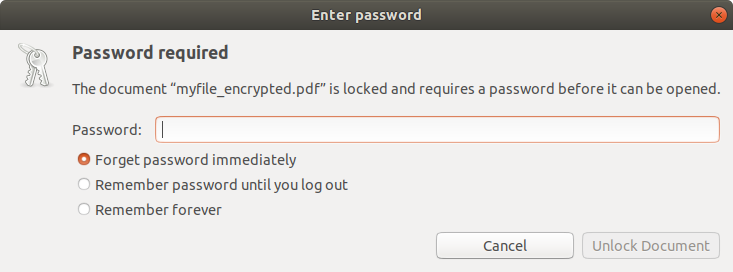使用 PyPDF2 加密和解密 PDF
PDF (便携式文档格式)是用于存储和发送文档的最常用的文件格式之一。它们通常用于许多目的,例如电子书、简历、扫描文档等。但是当我们将 pdf 共享给许多人时,其数据有可能被泄露或被盗。因此,有必要对我们的 PDF 文件进行密码保护,以便只有经过授权的人才能访问它。
在本文中,我们将了解如何设置密码来保护 PDF 文件。我们将使用PyPDF2 模块来加密和解密我们的 PDF 文件。 PyPDF2是一个作为 PDF 工具包构建的Python库。它能够:
- 提取文档信息(标题、作者……)
- 拆分和合并文档
- 裁剪页面
- 加密和解密PDF文件
安装
PyPDF2 不是内置库,因此我们必须安装它。
pip3 install PyPDF2
现在,我们准备编写脚本来加密 PDF 文件。
加密 PDF 文件
第一的, 我们将使用 reader 对象打开我们的 PDF 文件。然后,我们将创建原始文件的副本,这样如果出现问题,就不会影响我们的原始文件。要创建副本,我们必须遍历文件的每一页并将其添加到我们的新 PDF 文件中。然后,我们可以简单地加密我们的新 PDF 文件。
使用的 PDF 文件:

Python3
# import PdfFileWriter and PdfFileReader
# class from PyPDF2 library
from PyPDF2 import PdfFileWriter, PdfFileReader
# create a PdfFileWriter object
out = PdfFileWriter()
# Open our PDF file with the PdfFileReader
file = PdfFileReader("myfile.pdf")
# Get number of pages in original file
num = file.numPages
# Iterate through every page of the original
# file and add it to our new file.
for idx in range(num):
# Get the page at index idx
page = file.getPage(idx)
# Add it to the output file
out.addPage(page)
# Create a variable password and store
# our password in it.
password = "pass"
# Encrypt the new file with the entered password
out.encrypt(password)
# Open a new file "myfile_encrypted.pdf"
with open("myfile_encrypted.pdf", "wb") as f:
# Write our encrypted PDF to this file
out.write(f)Python3
# import PdfFileWriter and PdfFileReader
# class from PyPDF2 library
from PyPDF2 import PdfFileWriter, PdfFileReader
# Create a PdfFileWriter object
out = PdfFileWriter()
# Open encrypted PDF file with the PdfFileReader
file = PdfFileReader("myfile_encrypted.pdf")
# Store correct password in a variable password.
password = "pass"
# Check if the opened file is actually Encrypted
if file.isEncrypted:
# If encrypted, decrypt it with the password
file.decrypt(password)
# Now, the file has been unlocked.
# Iterate through every page of the file
# and add it to our new file.
for idx in range(file.numPages):
# Get the page at index idx
page = file.getPage(idx)
# Add it to the output file
out.addPage(page)
# Open a new file "myfile_decrypted.pdf"
with open("myfile_decrypted.pdf", "wb") as f:
# Write our decrypted PDF to this file
out.write(f)
# Print success message when Done
print("File decrypted Successfully.")
else:
# If file is not encrypted, print the
# message
print("File already decrypted.")输出:

这将创建原始文件的副本并使用输入的密码对其进行加密。 PDF一旦加密,不输入正确密码就无法打开。
解密 PDF 文件
但是如果我们想解密加密的PDF文件呢?我们也可以用这个来做到这一点 图书馆。过程几乎相同。我们将使用正确的密码打开加密文件,并通过遍历它的每一页并将其添加到我们的新 PDF 文件中来创建它的副本。
这是代码:
蟒蛇3
# import PdfFileWriter and PdfFileReader
# class from PyPDF2 library
from PyPDF2 import PdfFileWriter, PdfFileReader
# Create a PdfFileWriter object
out = PdfFileWriter()
# Open encrypted PDF file with the PdfFileReader
file = PdfFileReader("myfile_encrypted.pdf")
# Store correct password in a variable password.
password = "pass"
# Check if the opened file is actually Encrypted
if file.isEncrypted:
# If encrypted, decrypt it with the password
file.decrypt(password)
# Now, the file has been unlocked.
# Iterate through every page of the file
# and add it to our new file.
for idx in range(file.numPages):
# Get the page at index idx
page = file.getPage(idx)
# Add it to the output file
out.addPage(page)
# Open a new file "myfile_decrypted.pdf"
with open("myfile_decrypted.pdf", "wb") as f:
# Write our decrypted PDF to this file
out.write(f)
# Print success message when Done
print("File decrypted Successfully.")
else:
# If file is not encrypted, print the
# message
print("File already decrypted.")
这将创建不需要密码即可打开的加密文件的副本。
因此,这是加密和解密 PDF 文件的基本脚本。但是有很多想法可以扩展这一点。您可以创建一个GUI 工具来执行此操作或开发一个加密 PDF 文件的Web 应用程序。您还可以使用PyPDF2库创建一个完整的PDF 管理器。